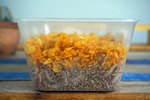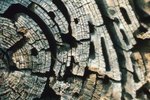
Paper or books that have holes, missing corners and skinned areas are signs that paper-eating insects are present. Evidence of paper-eating insects includes empty egg cases, skin casings shed by larvae, dead insects and a powdery, sawdust-like substance on bookshelves or near damaged paper. Paper-eating insects are attracted to starches, sugars and carbohydrates. Paper is a starchy food source for several bugs.
Silverfish
Silverfish are also known as Lepisma saccharina. They are small, wingless bugs that can't be seen by the naked eye. Adults grow to about 3/4 inches. Mature silverfish are light grey or silver toned and resemble fish. They prefer slightly wet, humid and moist habitats. Paper, wood, flour, wall paper, rolled oats and glue are common things silverfish eat within a household. They will also consume and damage book bindings, photographs and paper. Silverfish frequently eat paper that has ink, finding it more nutritious than the paper alone.
Cockroach
German, Oriental and American cockroaches are the most common species found in homes, eating paper goods. Cockroaches are attracted to moist and warm places, preferring to hide in dark places such as cracks and crevices located throughout homes. Kitchens, bathrooms, wet sponges, damp corners and leaking pipes are common habitats for cockroaches. They feed on a variety of foods including paper, books, glue, garbage, tobacco, fruit, bread, vegetables, grease and sweets.
Termites
Termite infestations in homes can go undetected for years. Termites are attracted to cellulose. Wood is an abundant source of the cellulose compound and is in the cell walls of plants and trees. Termites are attracted to all forms of cellulose, including refined forms, such as paper. Termites can chew through a variety of objects, causing damage and even dissolving the object completely, including book covers, bindings and pages.
Book Lice
Book lice are a common species of lice called Liposcelis bostrychophila, which frequently inhabit heated buildings. They are small, wingless insects that develop through a series of nymphal stages. Book lice feed on microscopic mold that is attached to cardboard, books and paper, grazing surface and causing damage to the objects. Large numbers of book lice will graze the surface of paper causing irreversible damage to the paper.
References
Resources
Photo Credits
-
Hemera Technologies/PhotoObjects.net/Getty Images
Writer Bio
Based in Miami, Shellie Alyssa has been writing articles since 2011. Her articles have appeared on a variety of popular and informative pet websites including munch.zone. In 2000, she was awarded an editors choice award for Outstanding Achievement in Poetry from the International Library of Poetry. She holds a fashion merchandising diploma from Penn Foster College.



